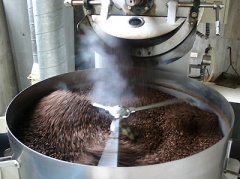Strong sweetness of Mexican coffee flavor manor area characteristics of varieties description of planting origin grinding

Heat a cup of milk, a teaspoon of cinnamon powder and a teaspoon of vanilla powder in a saucepan over medium heat. Then add cocoa powder, dissolve well and stir well. If you like chocolate, you can use chocolate paste instead of cocoa powder mixed with milk. Allow the milk to cool for about 5 minutes, then pour the coffee into the coffee cup, garnish the coffee with cold cream, and garnish with cinnamon. Chocolate and cinnamon aromas blend together to give off a desert flavor. Tasting such a cup of coffee, you feel as if you are walking through a desert zone full of vicissitudes.
Another way to combine Mexico's most famous tequila with coffee is to pour a small shot of tequila into the bottom of the glass before pouring milk and coffee, preferably garnished with cream and cinnamon. Tequila is a powerful drink, and if you're brave enough, try this alternative coffee. The Olmec civilization emerged in the tropical jungles of the San Lorenzo highlands of Central America around 1200 BC. San Lorenzo was the center of the early Olmec civilization, which flourished for about 300 years before
Destroyed violently around 900 BC. The center of Olmec civilization later moved to La Venta near the Gulf of Mexico. The Olmec civilization eventually disappeared around 400 BC and was replaced by the Ebiolmec culture. The exact cause of its disappearance is unknown, but it affected a large number of Mesoamerican civilizations. Many features of Olmec civilization, such as pyramid and palace construction, jade carving, jaguar and Quetzalcoatl worship, were also common elements of later Mesoamerican civilizations. Most scholars believe that the Olmec civilization was the mother of the Mayan, Zapotec, and Diotihuacan civilizations. However, it has also been suggested that the Olmec civilization was related to other Mesoamerican civilizations by sisterhood, with the Spanish invading Mexico in 1519 and the Aztec capital Tenochtitlán conquered by Spain and the Aztec's main enemies, the Tlaxcalteca, in 1521. But the Spanish did not conquer the Aztecs completely, but did so two centuries later, for two main reasons.
The Aztecs believed in constant human sacrifice for the universe to continue to function, so they sacrificed many people each year, mostly prisoners of war. But in times of peace, the Azreks resorted to a form of "ritual warfare" and had acquired prisoners of war. That was why the Traskaltka willingly joined the Spanish forces against the Azreks.
Another important factor was that the Spanish brought plagues and epidemics to America, smallpox, influenza, plague, measles, infecting hundreds of thousands of natives, and these epidemics probably killed about eight million natives.
The selection of Mexican coffee is generally done manually. The main basis for selection is according to the fullness of coffee particles, whether uniform, and then divided into grades. Generally speaking, coffee with full and uniform particles is easier to preserve. Only the purest and most uniform coffee beans can be roasted to represent the best and finest coffee in the country.
After the coffee beans are picked, they are spread out in a special room with ventilation on all sides. About a week later, the beans are packed in loose bags so that wind can blow through the bags. After about seven weeks, coffee beans change color and taste. Finally, these coffee beans are manually selected to select high-quality coffee beans and formally bagged for preservation.
Aldumara coffee beans are Mexico's top coffee beans, which are large in size, with intense sweetness, acidity and good aroma.
Mexicans are optimistic and enthusiastic by nature. It can also be seen from their coffee. The mellow Mexican coffee is not only loved by the native people, but also praised by many coffee connoisseurs. There are many ways to taste Mexican coffee, mainly divided into alcoholic and non-alcoholic two categories of practice Indeed, after drinking Mexican coffee, there is really a role in forgetting worries and removing troubles. Mexican coffee has a low taste and strong aroma. Although it is slightly bitter, it is very mellow. It has a unique and strong flavor. It is a wonderful product for afternoon tea and should be carefully tasted. It is also the best choice for blending other coffees and the first sip of coffee that beginners should taste. When you taste Mexican coffee, it's best to drink it hot. After an hour of hot coffee, all the aroma will be gone. If the coffee is not filtered, pour carefully, not stirring the coffee grounds, like slowly pouring an aged wine, not only to taste it, but also to appreciate its color. Alcohol-free mexican coffee is often paired with milk.
Important Notice :
前街咖啡 FrontStreet Coffee has moved to new addredd:
FrontStreet Coffee Address: 315,Donghua East Road,GuangZhou
Tel:020 38364473
- Prev

Taste of Mexican Fine Coffee with strong sweetness A brief introduction to the Origin and Development of Manor producing areas
The annual average temperature of the Mexican plateau is 2527 ℃; the climate of the Mexican plateau is mild all the year round, and the territory is mostly plateau topography, with no severe cold in winter, no heat in summer, and evergreen trees in four seasons, so it enjoys the laudatory name of the Pearl of the Plateau. Due to geographical and climatic reasons, the coffee growing area of Mexico is close to Guatemala, and the main producing area is Cora Begu.
- Next

A brief introduction to the aroma description of the characteristics of the manor producing area of Kenyan Jinchu Coffee
High-quality Kenyan coffee is aromatic, full-bodied and fruity, with a rich and perfect taste. Kenyan coffee has a wonderful fruit flavor, tastes like BlackBerry and grapefruit, and is a favorite of many coffee gluttons. This coffee has an excellent medium purity, crisp and refreshing taste. It has a fresh flavor and is most suitable for drinking iced coffee in summer. When tasting this coffee
Related
- Detailed explanation of Jadeite planting Land in Panamanian Jadeite Manor introduction to the grading system of Jadeite competitive bidding, Red bid, Green bid and Rose Summer
- Story of Coffee planting in Brenka region of Costa Rica Stonehenge Manor anaerobic heavy honey treatment of flavor mouth
- What's on the barrel of Blue Mountain Coffee beans?
- Can American coffee also pull flowers? How to use hot American style to pull out a good-looking pattern?
- Can you make a cold extract with coffee beans? What is the right proportion for cold-extracted coffee formula?
- Indonesian PWN Gold Mandrine Coffee Origin Features Flavor How to Chong? Mandolin coffee is American.
- A brief introduction to the flavor characteristics of Brazilian yellow bourbon coffee beans
- What is the effect of different water quality on the flavor of cold-extracted coffee? What kind of water is best for brewing coffee?
- Why do you think of Rose Summer whenever you mention Panamanian coffee?
- Introduction to the characteristics of authentic blue mountain coffee bean producing areas? What is the CIB Coffee Authority in Jamaica?

